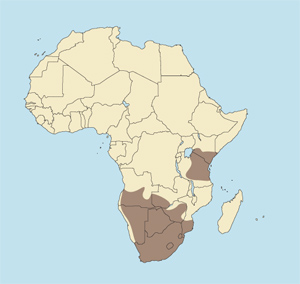 |
Raphicerus campestris
Steinantilope (Sp), Steinböckchen (G), Steenbok, Raphicère champêtre (F), Steenbok (Af). The common name is from the Afrikaans steen, referring to the animal's bricklike color. Sometimes called steinbok.
DESCRIPTION Shoulder height 20-21 inches (51-53 cm). Weight about 24 pounds (11 kg).
The steenbok is a small antelope, slim and elegant, with a short head, long legs and a short, smooth coat. The general color is a bright reddish fawn, tending toward brown in some individuals and gray in others. The underparts from chin to belly are white to yellowish white. There is a light-colored eye ring, a dark, wedge-shaped patch on the nose, and a dark, crescent-shaped patch on the crown. The ears are large and the tail is very short. There are no false hoofs. Horns (males only) are upright spikes, smooth and widely separated. Females are similar to males, although a little heavier and without horns.
BEHAVIOR Solitary, pairing up only when breeding. Territorial, marking its boundaries with dung heaps and secretions from its face glands. Its habits are not well known, but breeding appears to take place year-round, with one young born after about 5-1/2 months gestation. Females are sexually mature at 6-7 months, with the first birth possible at 12 months, and two births per year are the rule. Lifespan is about 10-12 years.
Mostly diurnal, steenboks can be seen feeding at any time of day. They are both grazers and browsers and seemingly are independent of water. Hearing is acute, vision and sense of smell not known. In presence of danger will usually lie flat in the grass. If this fails, will spring up and run off zigzagging, making occasional leaps, and stopping often to look back. Commonly takes refuge in old aardvark holes.
HABITAT Dry open plains and light woodland.
DISTRIBUTION Mainly in southern Africa, where it is found in southern Angola, southwestern Zambia, Namibia, Botswana, Zimbabwe, South Africa, and southern Mozambique. There is a separate population in southern Kenya and northern and central Tanzania.
REMARKS Should be taken with a small caliber or a solid bullet, so that the fragile skin will not be damaged.
TAXONOMIC NOTES Eight subspecies are listed: campestris, capricornis, fulvorubescens, kelleni, natalensis, neumanni, steinhardti and zuluensis. Differences are minor; we do not separate them.
|





